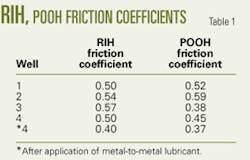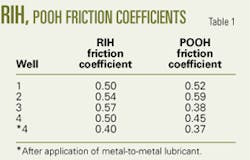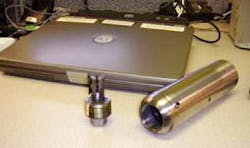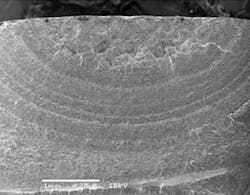This second of two articles reports on a study by BP Exploration (Alaska) of the behavior of 16Cr coiled tubing in field tests on the North Slope that led to the development of guidelines and operating procedures for continued work.
Published last week, Part 1 documents the testing and results of the lab and field studies, including general notes on handling and running 16Cr coiled tubing (CT). This part discusses metal-to-metal friction, coil life, pressure loss while pumping, acid treatments, failure analysis, conclusions about working with chrome CT, and ongoing testing.
Metal-to-metal friction
Chrome tubulars can damage carbon steel completions, and friction also develops between 16Cr and 13Cr tubulars. Metal-to-metal lubricants were shown to reduce friction coefficients and external wear.
L-80 carbon steel
In Alaska, it is well documented that abrasive chrome tubulars cause considerable wall damage to HS-80 CT. Typically, CT is retired after about 200,000 running ft (RF) due to wear caused by the hardness and rough finish of chrome tubulars. The shortened CT string life results in more frequent CT replacement, increased down time for CT change outs, higher costs, and an overall potential for personnel injury, environmental harm, and loss of well control due to more frequent pinhole leaks. Liquid metal-to-metal lubricants have been shown to increase the life of HS-80 CT but at additional job cost and time.
One of the potentially significant benefits of Quality Tubing Inc.’s QT-16Cr is that it is three to four times more resistant to abrasion than standard carbon steel CT. This is based on lab testing, in which 16Cr laps were rubbed against 13Cr API tubular material (used as the wear block).
Prior to start of the field trial, there was some concern that 16Cr could actually damage existing carbon steel completions, 13Cr completions, and 9Cr nipple profiles. Slurry abrasion response (wear) tests were done with wear blocks machined out of 13Cr and carbon steel and laps machined from QT-16Cr to ensure wear did not occur. The testing showed that wear was not a concern.
CT friction coefficient
Metal-to-metal friction coefficients of QT-16Cr CT inside 13Cr completions were calculated after completion of four jobs on wells with 13Cr completions. The run-in-hole (RIH) weight and pull-out-of-hole (POOH) weight were recorded continuously throughout the job. These weights were then modeled in a CT simulator to calculate friction coefficients.
There was some uncertainty built into the model due to varying wellbore fluids and flowing conditions. Friction coefficients were consistently higher than those calculated with HS-80 CT in 13Cr completions (Table 1) averaging 0.46 and 0.53 for POOH and RIH, respectively (compared to 0.25 and 0.34 with HS-80 CT inside 13Cr completions).
Quality Tubing has not performed any quantitative friction testing to date. Comparison tests with standard coiled tubing, however, showed that the friction was about the same. Although it is uncertain why the field test calculated higher friction coefficients, it may have been due to the increased residual strength mentioned earlier, resulting in more force exerted against the tubing.
Metal-to-metal lubricants
The recommended practice when running HS-80 CT in 13Cr completions in Alaska is to pump metal-to-metal lubricants into the wellbore prior to RIH whenever possible. This has been shown to reduce friction coefficients and external wear on the CT.
To determine if a corresponding friction reduction was observed with QT-16Cr CT,technicians circulated a lubricating fluid (1.5% lubricant, 1% KCl) downhole after RIH in Well 4. The RIH friction coefficient dropped to 0.40 from 0.50, while the POOH friction coefficient dropped to 0.37 from 0.45 (Table 1). This indicates that metal-to-metal lubricants can be effective for 16Cr.
Coil life
Assessing the useful life of coiled tubing is based on measuring outside diameter (OD), ovality, and WT over time:
Ovality, OD measurement
The QT-16Cr CT arrived from the manufacturer slightly oval at 1.75-in. x 1.77-in. (1.1% ovality). The dimensions were periodically spot checked with Vernier calipers throughout the field trial and showed virtually no change in ovality and OD readings.
Schlumberger’s universal tubing-integrity model (UTIM) device for constantly measuring CT OD and calculating ovality was not useful for QT-16Cr. Currently, tubing-integrity monitoring devices monitor ovality using magnetically induced eddy currents to detect the distance between the sensors and the CT.
These devices depend on the magnetic properties of the CT material. The probes are individually factory calibrated and temperature compensated for use with carbon steel CT. But 16Cr has significantly different magnetic properties and results in erroneous signals. To date, the manufacturer has not attempted to calibrate the UTIM for 16Cr and a new project would need to be initiated to determine if the current probes have enough range to be calibrated for its use.
Wall thickness
A rigorous effort was made to monitor WT during the field trial because of its direct relation to remaining CT life. In Alaska, CT is typically retired when wall loss is greater than 10% WT, or a corresponding WT of less than 0.121-in. for 0.134-in. wall CT.
WT measurements of new QT-16Cr CT were between 0.137-in. and 0.142-in. Measurements were taken every few hundred thousand RF with an MX-1 ultrasonic thickness gauge and Vernier calipers and showed a constant WT ranging between 0.130-in. and 0.148-in. with little abrasion loss during the field trial.
The published ultrasonic compression value (UCV) for QT-16Cr steel is 0.226 in./μsec (compared with 0.233 in./μsec for HS-80). This was confirmed in the field when compared with caliper measurements.
Schlumberger’s CT InSpec, which was unavailable during the field trial, is a real-time device that monitors both OD and WT for carbon steel CT using 12 ultrasonic probes, arranged radially. Ovality is calculated, similar to the UTIM.
An ultrasonic transducer is used to measure CT WT and can be accurately used for 16Cr CT, but OD determination (and thus ovality) is problematic. CT InSpec utilizes an elastomer packer to ensure good contact between the probes and the CT. The ultrasonic wave travels from the UT probe through the elastomer packer, reflects off the CT surface, and returns through the elastomer packer back to the probe. Sound velocity through the elastomer element is affected by temperature, which varies significantly due to friction between the CT and the element.
To compensate for this, CT InSpec uses a set of proximity probes (using magnetically induced eddy currents) to measure one diameter. This known diameter is then used to calculate the actual sound velocity in the polyurethane. So again, OD and ovality measurements will not be accurate due to the magnetic properties of 16Cr. The WT measurement, however, will be accurate because it is based on UT signal.
CT wear
Visual inspection of the 16Cr CT revealed some signs of surface wear. The observed damage, however, was much less than would be expected for HS-80 CT under the same conditions. Flat spots were occasionally observed on the outside of the bend in the coil, 5 ft up from the BHA, after multiple runs in 13Cr completions. The minimum and maximum OD measured at the flat spots was 1.748-in. x 1.770-in. Very small longitudinal scratches appeared on the CT surface after about 80,000 RF in 13Cr completions. These scratches would have appeared much sooner and been more dramatic in HS-80 coil run in 13Cr tubing.
Although running QT-16Cr inside 13Cr completions produced higher friction coefficients, the end results show that little abrasion occurred during its coil life. In Alaska, RIH and POOH speeds are limited to 80 fpm and 120 fpm, respectively, when in 13Cr completions, and 100 and 150 fpm in carbon steel completions.
The 16Cr CT was run at the higher running speeds in all wells, with no noticeable wear. Therefore, the additional friction discussed in the section above may not be an issue but is important to be known when 16Cr CT operations are modeled.
Pressure loss while pumping
Friction loss was determined in the field by performing step rate tests to investigate the potential benefit of higher pump rates through the smoother 16Cr when compared with carbon steel CT.
We conducted two tests: one with a 60%/40% by volume methanol-in-water mixture and the other with 1% KCl water and a drag-reducing agent. With 15,400 ft of CT at surface, the fluids were pumped through the CT, the lubricator, about 200 ft of 2-in. hardline, and out to open top tanks. Pressure losses through the lubricator and hardline were negligible and ignored. Fig. 1 presents results.
The test results were compared with a CT model’s prediction for pump rate and pump pressure. It was not feasible to make a direct comparison with 1.75-in. HS-80 CT in the field study because 1.75-in. CT strings used in Alaska are tapered to 0.109-in. from 0.134-in. WT. This tapering results in a changing ID, thus changing the fluid velocity and flowing properties throughout the CT length. Field observations suggested, however, that pump rates were similar to those of the tapered HS-80 string; there may be therefore a small CT wall-smoothness benefit. Some benefit may be observable in larger CT sizes.
Acid treatments
Poorly inhibited acid can ruin a chrome string in a single use, and according to Quality Tubing, there has been some resistance by major CT service providers to use 16Cr due to the high level of acid inhibition loading required to protect the CT from acid compared with carbon steel CT.
Two service companies were able to successfully determine effective acid corrosion inhibitor treatment rates for various types and percentages of acids commonly used on the North Slope, including HCl and mud acid. Inhibition loading for chrome is significantly higher, and material cost increase is 20% and 31% for 15% HCl acid and 9:1 mud acid, respectively.
In Alaska, this is insignificant because product cost is small in comparison with the overall cost of an acid job when CT costs and acid flow-back equipment are taken into account.
An ongoing field trial is determining inhibitor field effectiveness with HS-80 CT with a 2-in. jet swirl nozzle (Fig. 2) designed to hold a QT-16Cr CT corrosion coupon.2 CT corrosion rates vary depending on the internal stresses; therefore coupons are made from used pieces of the 16Cr CT.
To date, one test has been completed with 50 bbl of 10% HCl and standard corrosion inhibition (no chrome acid inhibition). Coupon weight dropped from 19.244 g to 19.238 g after the job, or 0.0012 psf, which is well within the industrial standard maximum allowable corrosion rate is 0.04 psf.
Running footage at failure
CT fatigue monitoring was a concern during the field trial because no model is yet available reliably to predict the life of 16Cr. The University of Tulsa acquired standard fatigue machine low-cycle and strain-controlled fatigue data that indicated that the fatigue life of QT-16Cr is considerably better than carbon steel CT. The data are being integrated and algorithms are being developed to model coil life but are not yet available. For this field trial, a conservative approach was taken and QT-16Cr coil life was modeled with the parameters for QT-1000.
To date, the QT-16Cr coil life has been 1.3 times that expected from HS-80 CT (922,500 total RF vs. 700,000 RF average). In 13Cr completions, however, QT-16Cr coil life has been 2.6 times that expected from HS-80 CT (528,200 RF vs. 200,000 RF average). The recent increased use of metal-to-metal lubricants has led to longer HS-80 coil life averages; however, QT 16Cr is still achieving significantly higher footages than HS-80.
Additionally, the string was successfully run in two 13Cr completions that have been particularly abrasive to HS-80 CT in the past. One well removed enough steel that an HS-80 string kinked at a bias weld, causing the string to be removed from service before the job could be completed. On another well, an HS-80 string was worn below minimum tolerance for WT and was removed from service.
The field test on QT-16Cr CT was ended after the second of two pinholes occurred (Table 2). These pinholes manifested themselves as cracks on the OD, running perpendicular to the length of the CT (Figs. 3 and 4).
The first occurrence was an isolated crack measuring about 1/2-in. in length, 1,000 ft from the downhole end of the CT after 700,000 RF. Inspection of the CT immediately adjacent to the crack showed no significant wall loss (0.134-in. WT above and 0.135-in. below) and no change in ovality from new coil.
These observations indicated that the crack was not likely due to pipe wear. One thousand ft of CT were cut off with a hydraulic cutter, and the reel continued performing wellwork interventions. The CT developed pinholes, again near the downhole end, after an additional 223,000 RF were completed (922,500 total RF).
The second occurrence was a series of hairline cracks running perpendicular to the length of the CT. The crack field was about 18-in. long and 3-in. wide, and the pinhole occurred in one of these hairline cracks. Both pinholes occurred in the same section. Following the second pinhole, the field trial was ended until failure analysis could be performed.
Remaining coil life
Analysis determined the cause of failure to be low-cycle fatigue cracking, with all cracks in the base metal away from the seam weld. Fatigue cracks propagated from origins containing corrosion pits. Investigating secondary cracks indicated that the origins contained high chromium constituents.
These high-chromium contents are localized metallurgical anomalies associated with the base steel-making process, not in the subsequent CT manufacturing. The failure mechanism was accelerated by the metallurgical anomalies that prematurely initiated both corrosion and fatigue cracks.
Adjacent material had evidence of good mechanical properties and remaining fatigue life; therefore the deleterious condition is intermittent. Steel without these anomalies can be used to make CT that will not suffer from premature fatigue failures. The steel supplier has tightened manufacturing controls to prevent and eliminate these metallurgical anomalies from the raw material and feels that the chance of recurrence of impurities is very low.
Fatigue cycle testing from a standard fatigue machine that used a 72-in. radius and 5,000-psi internal pressure was performed on three samples. Failure occurred at 820 cycles, 1,077 cycles, and 1,229 cycles and indicate that this QT-16Cr work string has close to 100 cycles over the goose neck left in its life, or about 1 million more RF (by taking the average and dividing by 4, the remaining number of CTU trips can be approximated: 260 trips).
A second reel of QT-16Cr has been placed in service on the North Slope. And BP’s coiled-tubing group in Alaska has placed an order for 2 3/8-in. CT.
Decisions
- 16Cr CT can effectively be used as a work string without major modifications to surface equipment or downhole tools.
- QT-16Cr CT has superior wear resistance when run in abrasive 13Cr completions and survived 2.6 times the life of HS-80 CT with negligible loss in WT.
- There was no noticeable improvement in pump rate vs. pump pressure when compared to HS-80 CT; however, further and more rigorous testing with other fluids and larger CT sizes should be undertaken.
- Testing showed that QT-16Cr is not adversely affected by methanol/water or common well-completion fluids.
Ongoing
Effective HCl and mud acid corrosion inhibitor treatment rates have been developed and laboratory tested for compatibility with QT-16Cr CT. Field testing using QT-16Cr corrosion coupons with the inhibited acid is in progress.
Although current CT integrity monitors are incompatible and there is no fatigue life model available, work is ongoing to address these requirements.
Acknowledgments
The authors thank the management of BP Exploration and our Prudhoe Bay partners for permission to publish this work.
References
- Martin, John, “QT-16Cr Coiled Tubing: A Review of Field Applications and Laboratory Testing,” paper 99857, SPE/ICoTA Coiled Tubing and Well Intervention Conference and Exhibition, The Woodlands, Tex., Apr. 4-5, 2006.
- Blount, C.G., Herring, G.D., and Patterson, W.W., “Acid Inhibition for Coil Tubing: Laboratory Screening and Field Verification,” paper 25498, SPE Production Operations Symposium, Oklahoma City, Mar. 21-23, 1993.








